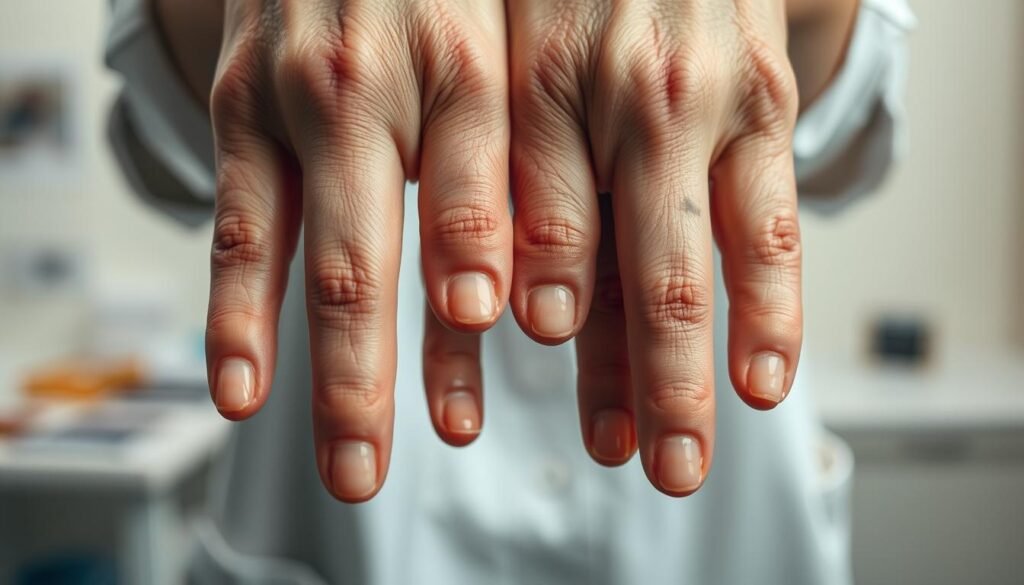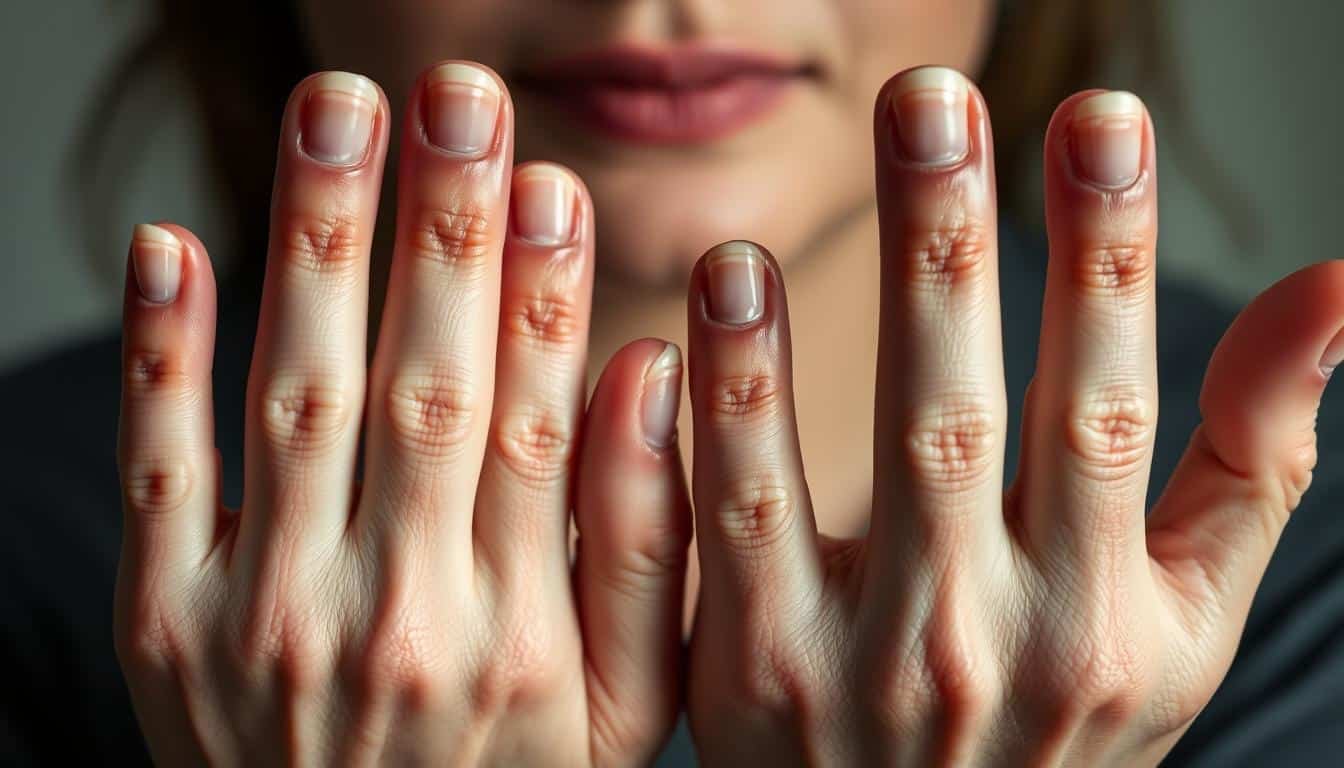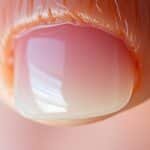Have you noticed changes in your nails that seem unusual or concerning? Your thyroid might be the culprit. Thyroid nail disease can manifest in various ways, often serving as an early warning sign of underlying thyroid disorders. From brittle, slow-growing nails to rapid growth and separation, these nail changes can be key indicators of your thyroid health.
Understanding the link between thyroid function and nail health is crucial for early detection and management of thyroid disorders. By recognizing these signs, you can take proactive steps to address potential thyroid issues before they escalate. Let’s explore how thyroid disorders affect your nails and what you can do about it.
Key Takeaways
- Thyroid disorders can cause significant changes in nail appearance and structure
- Brittle and slow-growing nails may indicate hypothyroidism
- Rapid nail growth and separation can be signs of hyperthyroidism
- Early detection of nail changes can aid in diagnosing thyroid disorders
- Recognizing thyroid-related nail symptoms can prevent complications
- Proper thyroid management can improve nail health
Understanding Thyroid Disease and Its Impact on Nails
Thyroid disease can greatly affect your health, including your nails. It’s important to understand how thyroid hormones impact nail growth.
The Role of Thyroid Hormones in Nail Health
Thyroid hormones are key for nail growth and health. If your thyroid gland doesn’t work right, you might see nail problems. For example, an underactive thyroid can cause brittle nails.
Common Nail Changes in Thyroid Disorders
Thyroid nail symptoms differ based on whether your thyroid is overactive or underactive. Here’s a look at nail changes in different thyroid conditions:
| Thyroid Condition | Nail Symptoms |
|---|---|
| Hypothyroidism | Dry, brittle nails with ridges |
| Hyperthyroidism | Soft, shiny nails that crumble easily |
| Both conditions | Slow nail growth, separation from nail bed |
Prevalence of Nail Issues in Thyroid Patients
Nail problems are common in people with thyroid disorders. Studies show many people with thyroid issues have brittle nails. If your nails keep changing, see your doctor for a check-up.
What Type of Thyroid Disease Attacks the Nails

Thyroid disorders can really mess with your nail health. Hypothyroidism and hyperthyroidism affect nails in different ways. If you have hypothyroidism, your nails might grow slowly and become brittle. They could also develop ridges or look thick.
On the other hand, hyperthyroidism can make your nails grow too fast. They might also separate from the nail bed.
Autoimmune thyroid conditions like Hashimoto’s and Graves’ disease can cause worse nail problems. These conditions can make your nails more brittle and lead to other nail issues. Many people with these conditions notice big changes in their nail texture and look.
One common nail problem in thyroid disorders is onycholysis, or Plummer’s nail. This happens when the nail separates from the nail bed. It’s more common in hypothyroidism cases. If your nails start lifting or separating, it could be a sign of a thyroid issue.
| Thyroid Condition | Nail Symptoms |
|---|---|
| Hypothyroidism | Slow growth, brittleness, ridges, thickening |
| Hyperthyroidism | Rapid growth, onycholysis |
| Autoimmune Thyroid Disorders | Increased brittleness, texture changes |
Knowing about these nail changes can help you spot thyroid issues early. If you see any odd nail changes, talk to your doctor. They can check your thyroid and suggest the right treatment.
Recognizing Nail Symptoms of Thyroid Dysfunction
Your nails can tell a lot about your thyroid health. Thyroid nail symptoms often appear before other signs, making them crucial for early detection. Let’s explore how different thyroid conditions affect your nails.
Hypothyroidism and Nail Changes
When your thyroid is underactive, your nails may become thick, dry, and brittle. You might notice visible ridges and slower growth. These changes happen because hypothyroidism slows down your body’s processes, including nail growth.
Hyperthyroidism and Nail Abnormalities
An overactive thyroid can cause opposite effects. Your nails might grow faster than usual, becoming soft and shiny. They may crumble easily, making everyday tasks challenging. These rapid changes reflect your body’s sped-up metabolism.
Onycholysis: A Key Indicator of Thyroid Issues
Thyroid onycholysis, also known as Plummer’s nails, is a significant sign of thyroid dysfunction. This condition causes your nails to separate from the nail bed, starting at the tip and moving backward. It’s often seen in both hypothyroidism and hyperthyroidism.
| Nail Symptom | Hypothyroidism | Hyperthyroidism |
|---|---|---|
| Texture | Thick, dry, brittle | Soft, shiny |
| Growth Rate | Slow | Rapid |
| Common Issues | Ridges, breakage | Crumbling, separation |
Other thyroid nail symptoms include white spots (leukonychia), striped nails, and pitting. If you notice these changes, consult your doctor for a thyroid evaluation. Remember, your nails can be the first clue to your thyroid health.
Diagnostic Approach for Thyroid-Related Nail Problems

Figuring out thyroid-related nail issues needs a careful look. Your doctor will check your nails and talk about your health history. This is key for spotting thyroid nail problems, as it helps rule out other causes.
Thyroid function tests are important in this process. They check your TSH, free T3, and free T4 levels in the blood. If these levels are off, it might mean you have a thyroid issue affecting your nails.
At times, a nail biopsy might be suggested. This involves taking a small nail sample for lab tests. A nail biopsy thyroid test can tell if nail changes are due to thyroid problems or other issues like fungal infections or psoriasis.
| Diagnostic Test | Purpose | What It Measures |
|---|---|---|
| Thyroid Function Tests | Assess thyroid activity | TSH, Free T3, Free T4 levels |
| Nail Biopsy | Rule out other nail disorders | Nail tissue structure and composition |
| Clinical Examination | Identify visible nail changes | Nail appearance, texture, and growth patterns |
Getting the right diagnosis is crucial for good treatment. If your nails look different, see your doctor right away. They can find out what’s wrong and how to fix it.
Treatment Options for Thyroid-Induced Nail Changes
Fixing nail problems from thyroid issues begins with treating the thyroid itself. Your doctor will suggest treatments based on your condition.
Thyroid Hormone Replacement Therapy
If you have hypothyroidism, your doctor might give you thyroid medication. As your hormone levels get better, your nails should too. Always take your meds as told and check in with your doctor often.
Topical Treatments for Nail Health
For stronger, healthier nails, try these:
- Moisturizing creams
- Nail hardeners
- Cuticle oils
Lifestyle and Dietary Modifications
Some lifestyle changes can help your nails:
- Protect your nails from harsh chemicals
- Keep nails trimmed and filed
- Eat a balanced diet rich in vitamins and minerals
Many find biotin for thyroid nails helpful. But, stop biotin 48 hours before thyroid tests to get accurate results.
“Proper nail care and protection are crucial when managing thyroid-related nail issues.”
By using these methods with your thyroid medication, your nails can get better. Always talk to your healthcare provider before trying new treatments or supplements.
Prevention and Management of Nail Issues in Thyroid Disease
Taking care of your nails is key when you have thyroid disease. Proper care can prevent damage and manage problems. Here are some tips to keep your nails healthy:
It’s important to regularly check your thyroid function. Make sure to visit your healthcare provider often. This helps prevent many nail issues before they begin.
Keep your nails clean and dry. Trim them regularly to avoid breakage. Avoid harsh chemicals that can weaken your nails. Wear gloves when doing tasks that involve a lot of water.
Moisturize your nails and cuticles every day. This simple step can greatly improve your nail health. It helps prevent dryness and brittleness often seen in thyroid conditions.
“Consistency in nail care routines can make a big difference for thyroid patients struggling with nail problems.”
Add nail-friendly nutrients to your diet. Biotin, vitamin E, and omega-3 fatty acids support nail strength and growth. Always talk to your doctor before starting any new supplements.
| Nail Care Action | Benefit | Frequency |
|---|---|---|
| Moisturize nails | Prevents dryness and brittleness | Daily |
| Trim nails | Prevents splitting and breakage | Weekly |
| Wear gloves | Protects from moisture and chemicals | During water-based tasks |
| Thyroid check-up | Ensures balanced hormone levels | As recommended by doctor |
By following these guidelines, you can manage thyroid nail problems well. You can keep your nails healthy despite thyroid disease challenges.
Conclusion
Your nails can reveal a lot about your thyroid health. Watching for changes in your nails might help catch thyroid issues early. This early detection can lead to quicker treatment and better results.
Thyroid health is closely tied to your overall well-being. Changes in nail texture, shape, or growth rate often signal thyroid problems before other symptoms appear. By noticing these signs, you can take action sooner.
Regular monitoring of your thyroid and nails is crucial. Work with your doctor to check your thyroid function and nail condition. With the right care and treatment, you can improve both your thyroid health and nail appearance. Remember, healthy nails often reflect a healthy thyroid.








Interesting read, but isnt it possible for poor diet to also impact nail health, not just thyroid disorders?
Isnt it odd that no one talks about how nail polish could potentially worsen these nail changes in thyroid disorders? Food for thought.
Interesting read, but isnt it strange how we always blame thyroid for everything? Maybe nails are just about nutrition and care? Just a thought.
Or maybe its strange how quickly we dismiss the impact of thyroid on our health? Just a thought.
Interesting read, but isnt it possible that nail issues could be due to poor diet or lifestyle, not always thyroid disorders?
Interesting read, but isnt it possible that nail changes could be more from stress rather than an underlying thyroid disorder? Just a thought.
Interesting read, but why arent we discussing if nail health can predict thyroid issues? Seems like a missed opportunity.
Interesting read! But dont you think the connection between nails and thyroid is a bit overstretched? Could it just be a coincidence?
Ever thought, maybe our nails are trying to warn us about these thyroid issues way before doctors do? Just a wild thought.
Interesting read, but why arent we discussing potential nail health benefits of hypothyroidism? Seems one-sided, dont you think? #NailHealthMatters
Interesting read, but isnt it more plausible that nail issues are from nutritional deficiencies rather than thyroid disorders? Just a thought.